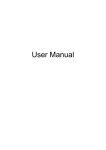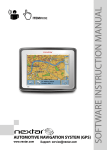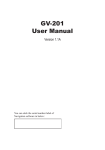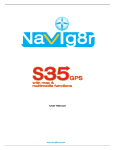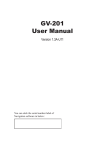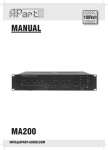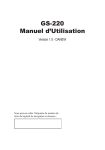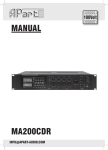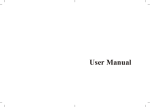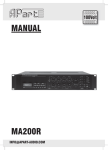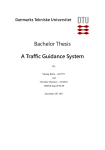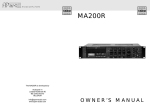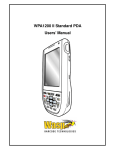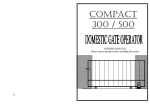Download User Manual - Navigation / Tracking
Transcript
User Manual 1 Using your navigator for the first time 1. Charge completely 2. Install into your vehicle 3. Initialize software as described in the manual 4. Make sure that the car is not undercover and it is not blocked by anything (trees, bridges, etc) 5. Normally it takes a bit longer to receive the GPS signal the first time you turn on the unit. Your device has to locate at least 4 satellites to function. This time to find the satellites is significantly shorter after the first time you use the device. If you move your unit over 300km without it being used, it may need a little more time to locate the satellites again. 6. Tinted and/or reflective glass can block or reduce the Satellite signal. It is best to try and locate the initial signal outside of the car. 2 Introduction This manual is a complete instruction for the device. Please read this manual carefully before using. Contents: 1 Using your navigator for the first time 2 Introduction 3 Safety and Regulatory Information 3.1 Important Safety Notices and Warnings 3.1.1 Global Positioning System 3.2 Precautions and Notices 3.2.1 Aircraft and Hospitals 4 Getting Started 4.1 Unpacking 5 Over View 5.1 Using Your Device in a Vehicle 5.2 Using the Car Bracket 5.2.1 Connecting the Car Charger 5.2.2 Connecting to AC Power supply and Charging the Battery 5.2.3 Assembly 5.3 Starting up 5.4 Power saving 6 Main Menu Selection 6.1 Navigation 6.2Vedio player 6.3Photo 6.4Ebook 6.5System 7 FREQUENTLY ASKED QUESTIONS 7.1 I can't find an address 7.2 There is a failure in the map / POIs are missing 7.3 Voice instructions are unclear in a specific situation 7.4 I have problems to get a GPS fix 7.5 Where can I get technical support? 7.6 Where can I get software updates? 7.7 Where can I get additional maps and guides? 7.8 How to Install the MSActiveSync? 7.9 How to download the files from the website and put in my SD Card? 7.10 What Kind of Formats Does The Device Support? 8 Connecting to Your PC 9 Troubleshooting and Maintenance 9.1 Resetting Your System 9.2 Troubleshooting 9.2.1 Power Problems 9.2.2 Screen Problems 9.2.3 Connection Problems 9.2.4 GPS Problems 9.2.5 Voice Too Low Or No Voice 9.3 Why cannot use my download files (Option) 9.4 Maintaining Your Device 10 Battery, Charger and Safety Precaution 10.1 About Charging 10.2 About the AC Adapter and the Car Charger 10.3 About the Battery 11 Specification 12 Navigation 13 Typographic conventions 14 Icons 15 Introduction 15.1 Key features 16 Getting started 16.1 Choosing a language 16.2 Setting the time zone 16.3 Safety precautions 16.4 GPS connection 17 Main elements 17.1 Main menu 17.2 Map 17.2.1 Tracking mode and browsing mode 17.3 Navigation screen 18 Main features 18.1 Choosing and finding locations 18.1.1 Search for an address 18.1.2 Searching for and choosing POIs 18.1.3 Choosing a location on the map 18.1.4 Favourites 18.2 Navigating 18.2.1 Browse map during navigation 18.2.2 Menu options 18.3 Planning a route 18.4 Settings 18.4.1 General settings 18.4.2 Map settings 18.4.3 Route options 18.4.4 Volume 19 Optional features 19.1 Guides 19.2 Traffic Message Channel (TMC) 19.3 Speed Camera Alert 20 Frequently asked questions 21 Copyright and license notes 3 Safety and Regulatory Information 3.1 Important Safety Notices and Warnings 3.1.1 Global Positioning System The Global Positioning System (GPS) is a satellite‐based system that provides location and timing information around the Globe. GPS is operated and controlled under the sole responsibility of the Government of the United States of America, who are responsible for its availability and accuracy. Any changes in GPS availability and accuracy or in environmental conditions, may impact the operation of your device .We cannot accept any liability for the availability and accuracy of GPS. 3.2 Precautions and Notices For your own safety, do not operate the controls of the product while driving.Use this product prudently. The product is intended to be used only as a navigation aid. It is not for precise measurement of direction, distance, location or topography. The calculated route is for reference only. It is the user's responsibility to follow the traffic signs and local regulations along the roads. When you get out of the car, do not leave your device on the dashboard or area of the car that is subject to direct sunlight. The overheating of the battery can cause malfunction and /or danger. GPS is operated by the United States government, which is solely responsible for the performance of GPS. Any change to the GPS system can affect the accuracy of all GPS equipments. GPS satellite signals can not pass through solid materials (except glass). When you are inside a tunnel or building, GPS positioning is not available. A minimum of 4 GPS satellite signals is needed to determine current GPS position. Signal reception can be affected by situations such as bad weather or dense overhead obstacles (e.g. trees and tall buildings) Wireless devices may interfere the reception of satellite signals and cause the reception of the signal to be unstable. For better signal reception, it is recommended that you use a car antenna (optional) 3.2.1 Aircraft and Hospitals Use of devices with an antenna is prohibited on most aircraft, in many hospitals and in many other locations. The device must not be used in these environments. 4 Getting Started 4.1 Unpacking Unpack your device box and identify the contents. You should have: (1) Unit. Its main features are a touch‐sensitive LCD screen, SD card slot, volume control switch. Details see the photo below. (2) Holder ‐ to hold the device. (3) Bracket ‐ its main features is to fix the device on a car . (4) Car Charger ‐ Standard 12V cigarette lighter adapter to provide power to your device in the vehicle. (5) AC adapter (Option) ‐ included for you to charge and work with your device even when not in the vehicle. When you use the adapter, please make sure it is cooled by placing it in a well ventilated area. (6) USB data cable for connecting your device to a Windows PC (7) GPS External Antenna (Optional) is used when the GPS signal is insufficient and it should be mounted on the top of the car or on the front of the car window. (8) SD card ‐ containing map data. (9) User Manual. (10) Installation CD (Optional) containing PC connection software and extra maps. *Note: please check optional accessories with your local retailer/importer/distributor. 5 Over View (1) Charger Indicator Light (2) Saving Power Switch(Remark: it is no use of this button when you playing MP3 and MP4,so pls DO NOT press it, if press it unguarded ,you have to reset the device then it can work) (3) GPS Antenna (4) Speaker (5) Reset Key (6) USB Connector (7) External GPS Antenna Connector (8) SD Card /MMC Slot: for accessing data as maps. Note:Before using GPS navigation software and maps, you need to insert the storage Card included with your device. Do not remove the card during GPS in operation. (9) Earphone Jack (10) DC Jack Do not expose the device to high temperatures. We recommend that you do not leave the device in direct sunlight for long periods or in an unattended car on sunny days. High temperatures can cause permanent damage. Do not attempt to service the device yourself! Do not open, puncture or disassemble it. Doing so may be dangerous and will invalidate your warranty. 5.1 Using Your Device in a Vehicle A stand and a car charger are supplied with your device. 5.2 Using the Car Bracket Caution: ‐‐ Select an appropriate location for the stand. Never place the stand where the driver's field of vision is blocked. ‐‐ If the car's windshield is tinted with a reflective coating, an external antenna (optional) maybe be needed to route the antenna to the top of the car through a window. When closing the car window, be careful not to pinch the antenna cable (Cars with an anti‐jam window design may automatically leave adequate space as needed.). ‐‐ If the unit has difficulty in locating adequate satellite signal during initial start up, take the unit out of the car and wait for a signal. ‐‐ The GPS signal can be blocked by trees, tall buildings, roofs and tinted glass. 5.2.1 Connecting the Car Charger The car charger supplies power to your device when you are using the device in a car. Caution: To protect your device against sudden surges in current, connect the car charger only after the car engine has been started. Connect one end of the car charger to the power connector of your device. Connect the other end to the cigarette lighter in the car to power and charge your device. To Cigarette Lighter 1.Device power connector 2.Vehicle power connector 5.2.2Connecting to AC Power supply and Charging the Battery 1. 2. 3. 4. Fully charge the battery before using your device for the first time Connect the adapter cable to the bottom of your device. Plug the AC adapter into a wall outlet. Also can use USB cable for charging The charge indicator glows amber when charging is in progress. Do not disconnect your device from AC power until the battery is fully charged, when the charge indicator turns green. This will take a couple of hours. It is recommended that the unit is unplugged from the mains socket when fully charged. 5.2.3Assembly To get started, put the device into the holder and assemble holder with bracket. Take off the protected film on the bottom of the suction. Then put the bracket onto a suitable location of your windscreen or side window, make sure the window or the suction or windscreen is clean and without water and some dirty things inside, fixing the stand on that position. Also ensure that the unit does not obstruct the view of the driver. Note: Control 5 different levels of suction by pressing down on the button (See below picture) Note: that some newer vehicles may have a heat reflective shield embedded in the windscreen. In some cases this can prevent proper GPS signal reception. If this turns out to be a problem in your vehicle, you will need to purchase and install the GPS external antenna kit. A temporary solution may be to take the unit out of the car into an open area to pick up the initial signal. The unit should be able to function normally thereafter. Under normal journey conditions, the suction mount is perfectly sufficient to hold the bracket in position. Note that suction may be lost if left overnight, due to condensation and low temperature. For this reason, and for security, we recommend removing both the suction mount bracket and the device when leaving your vehicle overnight. To remove the bracket, follow the steps as per below: Press the 2 side buttons, pull back lightly and then take off the suction. If the bracket still doesn't detach from your windscreen, tug gently on the clear plastic tab at the edge of the suction mount, to break the vacuum seal. 5.3Starting up Push the System Power button, The device will open, if push the button again, the device will off. (Suggestion: It will display the interface you were off last time.) Insert the supplied SD card containing the map data into the slot at the side of the device. Tap "OK "then enter the "Main Function Operation Screen " as below. Then select the functions you need and then go directly to the way you need. 5.4Power saving Press the power button on the top side of your device to turn on and off your device for saving power. When you press the power button to turn off the unit, your device actually enters a suspend state and the system stops operation. Once you turn on the system again, it resumes. 6Main Menu Selection The Main Menu is the start of all functions. It includes between two and six function icons such as navigation, Music with Mp3, Photo, Ebook, Video player with MP4 and system settings. 6.1 Navigation See Section 2 of this manual 6.2Video player 1)Tap "Video" icon on the Main Menu then go into the folder's interface as below: 2) Tap "Video" folder . you will see the display as below: Select the MP3 or MP4 documents,it will play automatically,and you will see the display as below: When you play MP4,you will enter into the full screen display, wherever you tap the screen,will enter into MP4 controller display,touch again, will back to full screen. 3) Tap " " and return to main menu. 6.3Photo 1)Tap "Photo" on the main menu and enter the following display 2) Tap "photo" folder again and enter into the following display 3) Tap the file on the screen and enter into the following picture. 4) Tap " " and return to main menu. Tips:Tap FULL SCREEN button, it will display in full screen size and playing all the photos automatically one by one (PPT) Tap PREVIOUS or NEXT button to view the pictures. If picture is too big or the device does not support the format,it will be dark screen or can not read 6.4Ebook 1. To read ebooks on the unit, Tap Ebook, you will see below display: 2) Tap folder "TEXT", then go into "Text List" interface, as below: 3) Tap the file on the picture and enter into the following display. 6.5System Tap the icon "System" on the main menu and enter into the following setting. 1) Tap the icon "Backlight" and enter into the following display. Under BACKLIGHT icon tap ‐ to reduce the brightness tap + to increase the brightness of the backlight 2) Tap the icon "Sys Info" and enter into the following display Tap "Calibration" and enter the adjustment of touch screen According to the information on the screen press the centre of the cross Then take the operation under instruction until the following screen displays. 3) Language a. Tap the icon "Language" and enter into the following display. Please Note: This does not affect the Navigation Language. 4) Power Tap the icon "Power" and enter into following display. 5) Volume A. Tap the icon "Volume" and enter into volume setting display. B. Tap "‐" or "+" to adjust volume of speaker. 6) Date and Time a. Tap the icon "Date and Time" and enter into the following display. b. Tap DATE icon and use < or > icon to adjust the date. C. Tap TIME icon and use < or > icon to adjust the time. 7 FREQUENTLY ASKED QUESTIONS 7.1 I can't find an address. Please make sure you have correctly spelled your entry. If you do not know how an address is spelled correctly, simply enter the parts of the address, you know for sure (e.g. "Lond", "Leic" for Leicester Square in London). Then browse in the result list and look for the address. Also make sure that the city in which you are looking for an address is correct. Sometimes the official postal address differs from the address you are looking for. In that case, search for an address nearby that you know of and browse on the map. 7.2 There is a failure in the map / POIs are missing. If you detect an error in the map data (e.g. a street is missing completely), we would like to inform our map data provider. Please email [email protected] 7.3 Voice instructions are unclear in a specific situation: If you could not fully understand the voice command for a maneuver, either hit the repeat command button or ask your companion to take a look at the map. 7.4 I have problems to get a GPS fix. If you have problems getting a satellite fix with the GPS (you can see how many satellites are being received on the main menu at the bottom left) please make sure, that you are outside and the GPS antenna has a good visibility to the open sky. Some models also support an additional external active antenna. Please also consult with the hardware manual of your device to get further information of how to obtain a GPS fix. 7.5 Where can I get technical support? Please email [email protected] or visit www.navig8r.com.au 7.6 Where can I get software updates? Please email [email protected] or visit www.navig8r.com.au 7.7 Where can I get additional maps and guides? Please email [email protected] or visit www.navig8r.com.au or your retail store for information about software updates. 7.8 How to Install the MSActiveSync? ActiveSync allows you to establish a connection and transfer files (i.e. MP3 Files) between your device and your computer Caution: Do not connect your device to your computer before ActiveSync is installed. Down the "MsActiveSync" from Microsoft? Http://www.microsoft.com/windowsmobile/downloads/ activesync42.mspx Step 1: Turn on your PC and your device, then connect using the supplied USB cable. Step 2: After Wizard display, press "NO" and then press "Next". Step 3: Tap "Explore" button. Step 4: Copy the Map file to the "Cities" file of the SDMMC folder. 7.9 How to download the files from the website and put in my SD Card? Step 1: Turn on your PC and your device, then connect them using USB cable. Step 2: After Wizard display, press "NO" and then press "Next". Step 3: Tap "Explore" button. Step 4: Enter into the MEDIA file of the SDMMC Put Music files & Movie files to Video Directory Put photos and pictures in the Photo Directory Put the web files to TEXT Directory Put the map in the Cities Directory 7.10 What Kind of Formats Does The Device Support? Support Music /Movie Format: AVI,ASF,WMV,WMA,MP3,WAV Support Picture Format: JPG,JPEG,BMP,GIF,PNG Support E‐Book Format: TXT 8 Connecting to Your PC There are two ways to update or change the maps, the software or multi‐media files to your device. You'll probably want to link it to Your PC. 1. Using a Card‐reader (not supplied) 1.1. Insert the SD Card into the card‐reader and USB cable to connect with PC. 1.2. Copy the update maps/software/multi‐media files to the correct folder on your SD Card 1.3. Take out the SD Card from the card‐reader and insert into your device. 1.4. Use the device as per normal 2. Using MS ActiveSync software 2.1. Set up the MSActiveSync on the PC (See 7.8 How to install the MSActiveSync?) 2.2. Connect the device and PC via USB cable 2.3. MSActiveSync will run automatically once the device is connected with the PC (But ensure the device is powered on) 2.4. Put the map/software/multi‐media files to the correct folder on the SD Card ***Remarks: Map and software update must be done according to software instructions 9 Troubleshooting and Maintenance 9.1 Resetting Your System Resetting your system is similar to restarting your computer. Occasionally, you may need to reset your device. For example, you should reset your system when it stops responding or appears to be "frozen" or "locked up To reset your system, press the Reset button on left side of your device. If your device still does not respond after being reset, you can use the following steps to clear the memory, and reset the system settings to factory defaults. Disconnect all cables, including the AC Adaptor, from your device. Use the stylus pen or your finger to slide the ON/OFF switch to the OFF position Wait for 1 minute and then slide the switch back to the ON position. Your device will automatically turn on and the Main screen will appear. Note: Once you clear the memory with this ON/OFF switch, all the settings you have changed in the System Settings will be erased, you need to re‐enter any personal settings, including time and date once again. 9.2 Troubleshooting 9.2.1 Power Problems Power does not turn on when using battery power > Make sure the power switch is already in ON position > The remaining battery power may be too low to run your device. > Connect the AC adapter to your device and to AC power or Connect the Car Charger to your device and to external DC power. 9.2.2 Screen Problems A. Screen is off a. If the screen does not respond even after you press the power button, try the following in order until the problem is solved: i. Connect the AC adapter to your device and to external AC power. ii. Connect the Car Charger to your device and to external DC power. Iii. Reset your system. B. Screen responds slowly a. Make sure that your device is not running out of battery power. C. Screen freezes a. Reset your system. D. Screen is hard to read a. Make sure that the power is enough b. Make sure that the backlight of the display is on c. Move to a location with more light d. If the problem still exists, reset your system. E. Inaccurate response to stylus pen taps or finger tip a. Recalibrate the touch screen. 9.2.3 Connection Problems Cable Connection Problems →Make sure that your device and your computer are both turned on before trying to establish a connection. →Make sure that the cable is securely plugged into the USB port on our computer and on the device. Connect the USB cable directly to your computer →Reset your device before connecting the cable. Always disconnect your device before you Restart your computer. 9.2.4 GPS Problems When there are no valid signals available, consider the following: →Make sure that the GPS antenna is adjusted to the horizontal position (parallel to the ground) and it has a clear view of the sky. →Note that the GPS reception can be affected by: ‐ Bad weather. ‐ Dense overhead obstacles (e.g. trees and tall buildings). ‐ Other wireless devices in the car. ‐ Reflective car window tint. 9.2.5 Voice Too Low Or No Voice If anything is plugged into the earphone jack then the all sounds will be routed through the earphone. Unplug the earphones to get sound back through the speakers. Rotate the Volume Switch to the + position and upwards Check the Sound Settings on your System, make sure the voice setting is correct and the level of the voice volume. 9.3 Why cannot use my download files (Option) The file format is not supported The file is not in the correct folder Mp3 & MP4 Folder is as SD card \media\video JPG, BMP file Folder is \media\pic Map and navigation Voice is: SD Card \Cities\... 9.4 Maintaining Your Device Taking good care of your device will ensure trouble‐free operation and reduce the risk of damage to your device. →Keep your device away from excessive moisture and extreme temperatures. →Avoid exposing your device to direct sunlight or strong ultraviolet light for extended periods of time. →Do not place anything on top of your device or drop objects on your device. →Do not drop your device or subject it to severe shock. →Do not subject your device to sudden and severe temperature changes. This could cause moisture condensation inside the unit, which could damage your device. In the event of moisture condensation, allow the device to dry out completely before use. →Take care not to sit on the device. We advise not to carry the device in one’s back pocket for that reason. →The screen surface can easily be scratched. Use the stylus or your fingers to tap on the screen. →Avoid touching it with any sharp objects. Non‐adhesive generic screen protectors designed specifically for use on portable devices with LCD panels may be used to help protect the screen from minor scratches. →Never clean your device while powered on. Use a soft, lint‐free cloth moistened with water to wipe the screen and the exterior of your device. →Do not use paper towels to clean the screen. →Never attempt to disassemble, repair or make any modifications to your device. Disassembly, modification or any attempt at repair could cause damage to your device and even bodily injury or property damage and will void any warranty. Do not store or carry flammable liquids, gases or explosive materials in the same compartment as your device, its parts or accessories. 10 Battery, Charger and Safety Precaution 10.1 About Charging →Use only the AC adapter and the DC Car Charger supplied with your device. Use of another type of AC adapter or Car Charger may result in malfunction and/or danger. →The AC adapter input is rated 100~240V AC,50/60Hz, 0.35A, output rated +5V DC / 2.0 A, The DC Car Charge is input rated DC input 12V DC output 5V, 2A. 10.2 About the AC Adapter and the Car Charger →Do not use the adapter or the car charger in a high moisture environment. Never touch the adapter when your hands or feet are wet. →Allow adequate ventilation around the adapter or the car charger when using it to operate the device or charge the battery. Do not . cover the AC adapter or the car charger with paper or other objects that will reduce cooling. Do not use the AC adapter while it is inside a carrying case. →Connect the AC adapter to a proper power source. The voltage requirements are found on the product case and/or packaging. →Do not use the adapter or the car charger if the cord becomes damaged. →Do not attempt to service the unit. There are no serviceable parts inside. Replace the unit if it is damaged or exposed to excess moisture 10.3 About the Battery →Use only the specified charger approved by the manufacturer. →CAUTION: This unit contains a non‐replaceable internal Lithium Ion battery. The battery can burst or explode, releasing hazardous chemicals. To reduce the risk of fire or burns, do not disassemble, crush, puncture, or dispose of in fire or water. →Important instructions (for service personnel only) ‐ Replace only with the same or equivalent type recommended by the manufacturer.。 ‐ The battery must be recycled or disposed of properly. ‐ Use the battery only in the specified equipment. CAUTION: Risk of explosion if battery is replaced by an incorrect type. Dispose of used batteries according to the instructions. 11 Specification CPU: Atlas II 926 SDRAM: 64M Bytes ROM: 32/64 MB NAND Flash Display: 3.5" TFT LCD with Touch Panel, resolution 320 x 240 Map storage: SD/MMC Card USB Device: USB 1.1 OS: Microsoft Windows CE.NET 5.0 Working temperature: 0~60o C Storage temperature: ‐20 o C~80 o C Power: 5V, 2A 1 2Navigation 13 Typographic conventions Bold Items you must select, such as menu options, command buttons, or items in a list. ● Bullet Step‐by‐step procedures. You can follow these instructions to complete a specific task. ● Comment Especially important or noteworthy information. ● Monospace Information that you must type, or information like folders and filenames. ● CAPITALS Names of keys on the keyboard. For example, SHIFT, CTRL, or ALT. 14 Icons The following icons are used throughout the application: 15 Introduction You have chosen a cutting‐edge navigation system. Please enjoy using it. This navigation system leads you straight to your destination, whether you are traveling by car or on foot. You can navigate and plan your route with an easy to use and intuitive interface, just by using your finger. You can also use this application to plan your trip to suit your personal preferences and interests and to find and save interesting destinations before you set off on your journey. This manual leads you through the features of the system. 15.1 Key features ● Voice‐guided navigation ● Cross‐border navigation in Europe based on a 1 GB map (optional feature) ● Dynamic Traffic Information, TMC (optional feature) ● Real pedestrian mode through parks and open spaces ● Trip planning ● Look‐ahead search function ● State‐of‐the‐art polygon view of individual buildings for selected cities (optional feature) ● Earth browsing – zoom from satellite view to street‐level ● Unique night mode ● State‐of‐the‐art guidance engine ● Premium content based on branded guides (optional feature) 16 Getting started Please make sure that the battery in your device is fully charged. ● Switch on the unit and tap on NAVI or NAVIGATION in the first screen. 16.1 Choosing a language If more than one language is available on your device, you will be prompted to choose the desired language. ● Click on the flag representing the desired country/language. ● On the following screen, choose the voice skins used for the voice commands during navigation (e.g. female or male voice). 16.2 Setting the time zone Your PND is able to automatically determine the time through the GPS signal. For this purpose, you need to set your time zone. ● Choose your time zone from the list. It can be changed at a later time . ● Press the confirmation icon. 16.3 Safety precautions Next, a screen with safety precautions will be shown. ● Read the safety precautions. ● To hide these notes for future start‐ups, select Hide at Startup. ● Press the forward arrow. 16.4 GPS connection Your PND uses Global Positioning System (GPS) technology for navigation. The device receives signals from a number of GPS satellites in order to determine your current position. ● Place your PND in a location with an unobstructed view to the sky to set up your first satellite connection. In a car this will usually be on the dashboard. It may take up to 5 minutes to establish the first connection. Subsequent connections will be faster (30 seconds to 1 minute), but if you have not used the unit for several days or are very far away from the last location where you used it, it may take up to 5 minutes again to find a strong signal. 17 Main elements 17.1 Main menu The main menu is your central point of access to all functions of your Personal Navigation Device. It allows you to find and set your destination, manage your favourites and control all settings of your device. On the left hand panel, there are three buttons. Click on one of the buttons to open a set of sub options on the right‐hand side of the screen: ● Destination lets you choose your destination‐ either by searching for an address, choosing an entry from the POI directory or a city guide , selecting a location from the map or a recently visited location. ● Favourites allows you to manage your favourites (like bookmarks, recently visited locations, trips). You can rename, sort or delete them. ● Use Settings to configure your Personal Navigation Device to suit your needs. Define general settings (e.g. time, language, system of measurement, configure your map (e.g. 2D or 3D mode, day or night mode, map complexity) or load a map of a different region, set the route options (e.g. choose to avoid or allow toll roads or ferries or select your mode of transportation, or adjust the volume. 17.2 Map The map is the core component of your Personal Navigation Device. It is centred on your current location by default, provided you have a GPS connection. You can browse the map, display information about the different locations shown on it and e.g. choose them for routing and navigating. 17.2.1 Tracking mode and browsing mode The map has two basic states, tracking and browsing. In the tracking mode, the map follows your actual position (GPS position), displaying information about your geographic position, your speed, etc. The GPS position is indicated through the crosshairs. As soon as you browse the map, you enter the browsing mode: ● Use a pen or your finger to browse the map. The selected position will be identified by a cursor. Clicking on an icon on the map will open an overlay window with information about the selected item. ● To zoom in or out, press the + or ‐ icons. As soon as you press one of the icons, the zoom slider is displayed to enable smooth zooming. ● If you want to return to the tracking mode, press the back icon. 17.3 Navigation screen The navigation screen displays your route (in blue) and your surroundings. The GPS position symbol identifies your current position. The red arrow indicates the direction of your next turn. The upcoming maneuver is always displayed in the upper left corner‐ together with the distance to it. When you approach a turn, there will be a voice command at the appropriate time. On the left side, additional information is displayed, such as estimated arrival time, and the distance to your destination. ● When you tap on the left side, it turns into a big speed indicator. Tap again to return to the original view. ● For one‐way streets, the direction of travel is indicated by a blue arrow. For more information about navigation. 18 Main features This chapter describes the functions of your Personal Navigation Device in detail. On the following pages you will learn how to ‐ Find and choose locations ‐ Navigate to your destination ‐ Use the route planner ‐ Configure the application 18.1 Choosing and finding locations This section describes the different ways of finding and choosing locations. You can search for an address, browse Point of Interest (POI) directories and city guides, choose locations on the map, and choose one of your favourites (like home and work address, your bookmarks and recently visited locations). 18.1.1 Search for an address Use the address search function to find an address. Just enter information about the desired destination, select an entry from the results list and use the address found for different purposes, such as showing it on a map, planning your route or navigating. ● In the main menu, press Destination. ● Press Address. The Find Address window will be displayed: ● Enter the appropriate data to find your address. 18.1.1.1 How to search Your Personal Navigation Device offers a convenient interactive look‐ahead search function to prevent misspelling. Only keys that lead to a search result can be pressed – all others are inactive! ● Enter the first two characters. You will see that the some keys on the keypad turn inactive. You can only choose active keys: ● Enter the second character. Again, some keys will turn inactive; others will turn active, depending on your choice. ● Keep on entering characters until you have narrowed down the search to only one result. OR ● Press the search icon (magnifying glass). A result list will be displayed. ● Choose the appropriate entry from the list. Switch between letter and number mode by pressing 123 or ABC. Switch between upper case and lower case by pressing ^. If at any point you want to go back and delete characters, press the backspace button <‐ on the screen. To add a space, press the space bar _. If you need to enter an apostrophe (') use the space key instead. 18.1.1.2 Set the country ● To select your country, press State/Prov. ● Choose your country from the list. The State/Prov. field will be populated with the name of the chosen country. Enter a post code Instead of a city you may enter a post code. ● To enter a post code, press Post Code. ● Enter the post code of the town/city you are looking for. ● Press the search icon (magnifying glass). A hit list will be displayed. ● Choose the appropriate town/city from the list. You will return to the Find Address screen. The City and Post Code fields are populated with the chosen city/post code. 18.1.1.3 Search for the city ● To select a city, press City. ● Search for the city, as described above. A result list will be displayed. ● Choose the appropriate town/city from the list. You will return to the Find Address screen. The City field is populated with the name of the chosen town/city. 18.1.1.4 Search for the street ● To select a street, press Street. ● Search for the street, as described above. A result list will be displayed. ● Choose the appropriate street from the list. You will return to the Find Address screen. It will be filled with the data previously entered. ● You may also enter the number. 18.1.1.5 Navigate to the address found Once you have narrowed down your search to a unique address, you can start navigation. Press the menu icon to access further options: ● To navigate to the location, press Navigate. ● To use the location for planning a route, press Via. ● To save the location as a bookmark, press Save. ● To show the location on the map, press On Map. 18.1.2 Searching for and choosing POIs The POI finder allows you to quickly find points of interest like petrol stations and restaurants in a database of millions of POIs. These places can be nearby or at a remote location. Where? displays the starting point for the search. POIs near that point will be displayed. This is usually your current location. To set a starting point other than your current location, press Where?. ● In the main menu, press Destination. ● Press POI Search. ● The POI Search screen will be shown: 18.1.2.1 Choosing a POI ● Select the desired POI category. A menu with subcategories will be shown. ● Select a subcategory (if applicable). ● To return to the previous category, press the back icon. A list of POIs will be shown. ● Select a POI by clicking on it. A menu with a set of actions will be displayed: ● To navigate to the location, press Navigate. ● To use the location for planning a route, press Via. ● To save the location as a bookmark, press Save. ● To show the location on the map, press On Map. ● To show information about the location (if available), press Description. 18.1.2.2 Searching for a POI ● To enter a search keyword, press the search icon. ? Enter the search keyword (at least three characters), and press the confirmation icon. A list of POIs will be shown. ● Select a POI by clicking on it. A menu with a set of actions will be displayed, as described above. 18.1.3 Choosing a location on the map An easy way to choose a location is selecting it on the map. Browse your surroundings and choose any street or location to use it for navigation or routing. ● In the main menu, press Destination. ● In the main menu, press Map. ● Point the cursor at any place on the map. The name of a selected location/street will be shown in the info box. ● Press the menu icon. From the following menu you can choose to be guided to the address, use it for route planning, show it on the map, search for POIs, change the map settings, etc. 18.1.4 Favourites Use your frequently used or favourite destinations for guidance. You can choose among your bookmarks, recently visited locations, previously saved trips, and presets (e.g. your home or work place). ● In the main menu, press Destination. ● In the main menu, press Favourites. The Favourites menu will show on the screen: 18.1.4.1 Bookmarks The bookmarks list contains the destinations you have saved as favourites (from the guides, by choosing it on a map, etc.). This means that you do not need to perform repeated searches for those destinations. ● Press Bookmarks. The bookmark list will show on the screen: Use the up and down arrows to scroll up and down in the list. ● Select an item by clicking on it. A menu with a set of actions will be displayed: ● To navigate to the location, press Navigate. ● To use the location for planning a route, press Via. ● To sort the list of location alphabetically, press Sort. ● To show the location on the map, press On Map. ● To delete the selected location, press Delete. ● To edit the location, press Rename. ● To delete all location, press Delete all. 18.1.4.2 Recent By pressing Recent a list of recently visited or looked‐up destinations will be opened. ● Press Recent. The list of recent locations will show on the screen. Use the up and down arrows to scroll up and down in the list. ● Select an item by clicking on it. A menu with a set of actions will be displayed, as described above. The available options may vary. 18.1.4.3 Trips ● To access to your previously saved trips, i.e. routes, press pressing Trips. 18.1.4.4 Presets You can save your home and street addresses as presets for quick access. ● Press Home and Work. ● Press My Home. A menu with a set of actions will be displayed: ● To navigate to the location, press Navigate. ● To edit the location, press Rename. ● To delete the location, press Delete. ● To show the location on the map, press On Map. ● To use the location for planning a route, press Via. Error! Bookmark not defined. ● To delete all locations, press Delete all. ● If no home address has been set, you are prompted to do so. You can choose it by searching for an address, through your current GPS position or by choosing a recently visited location. Proceed similarly with your work address. 18.2 Navigating The powerful navigation capabilities of your Personal Navigation Device guide you along the shortest or quickest route from A to B‐ with voice commands and in 3D. This section describes the navigation feature. See17.1 for information about choosing elements on the map. See 18.1 for information about finding and choosing addresses, POIs, and locations inside a guide. Choose a location through Destination, and press Navigate in the respective menu. Your route will be calculated. The navigation screen will be displayed. 18.2.1 Browse map during navigation You can browse the map even while navigating. This way you can easily choose a new destination if you change your mind. However, navigation will not be interrupted‐ you will be still guided through voice commands. Press the back icon to follow the route on screen again. 18.2.2 Menu options ● To open a set of navigation options during navigation, press the menu icon: Here you will find the following items: Alt. route With this option, you can choose to block the calculated route for a given distance (e. g. 0.5 km) and force an alternative route. Simply tap on the icon which shows the desired distance. Your route will be Recalculated, and the previous route will be discarded for the given distance. List of waypoints Opens a list of the waypoints (manoeuvres) along your route. Save Save your actual position as a bookmark. Volume Alter the volume of the voice commands. Search You can redirect your route by choosing a point of interest (POI), like a petrol station. Redirecting means either setting a new destination or adding a new stopover. Settings Change the settings of your Personal Navigation Device, as described 18.4. 18.3 Planning a route This section describes the route planning feature. This feature allows you to plan your route in advance, choosing multiple stopovers along your journey. See17.1 for information about choosing elements on the map. See 18.1 for information about finding and choosing addresses, POIs, and locations inside a guide. ● Choose a location on the map or through Destination, and press Via in the respective menu. ● The Destination List will be displayed: The location will be added to the Destination List. ● To add another stopover, press the + icon. ● You will switch to the Choose stopover: screen. You may choose stopovers like your home or work addresses, a bookmark, a point of interest, a recent location or by searching for an address or pinpointing a destination on the map. Once you have added stopovers (with the + icon) and returned to the Destination List, you have several options: ● With the + icon you can choose additional stopovers. You can add up to six stopovers. ● To change the order of the stopovers, select a stopover and then use the up and down arrows to move it up/down in the list. ● With the trash icon you can delete a selected stopover. Once you have chosen your route, you have several options. You reach those options by pressing the menu icon (bottom right‐hand corner of the screen). ● To simulate the route to come, press Simulate. ● To start guidance, press Start Navi. The display will switch to the navigation map. ● To calculate the route, press Routing. The Route Summary will be displayed. Tap on one of the items in the Route Summary to display the Waylist. Tap again to show the map view. ● To save the route as a favourite trip, press Save as. 18.4 Settings You can configure your Personal Navigation Device to suit your needs. When it comes to navigating, you can, for example, choose to avoid or allow toll roads or ferries or select your mode of transportation, like a fast or slow car, a scooter or even your own feet. You can also edit several display settings, such as 2D or 3D mode, day or night mode, map complexity, etc. ● In the main menu, press Settings. 18.4.1 General settings ● Choose General to change the general settings. The window with the general settings will be shown: ● To choose the language, press Language. ● To change the time zone, press Set time. ● To change the system of measurement, press Miles or Kilometres. ● To show information about the application, press About. 18.4.2 Map settings ● Choose Map Settings to change the map settings. The window with the map settings will be shown: ● To toggle between night and day modes, press the corresponding icon. By selecting Automatic, the mode will be chosen depending on the actual time. ● To select a map, press Maps. If you have map data for different regions/cities on your memory card, tap on the name of the current region (e. g. London). All available maps on the memory card will be listed. You can choose the desired region by simply tapping on its name. ● To toggle between 2D and 3D modes, press the corresponding icon. ● To optimize the map orientation during navigation, press Track Up. To keep the map oriented to the north, press North Up. ● To select which kinds of elements will be displayed on the map, press Info Layers: ● Check the boxes of any category you want to have displayed on the map. Uncheck those that should be hidden. ● This will have no impact on any search you perform. ● To apply your settings, press the confirmation icon. ● To return to the previous screen, press the arrow. 18.4.3 Route options ● Choose Route Settings to change the route options. The window with the route settings will be displayed: ● To switch between the modes just touch the icons. These will toggle so you can quickly see the activated settings. You can choose among the following options: Mode of transportation (fast car, slow car, motorbike, pedestrian, etc.), fastest or shortest route, allow or avoid toll roads, motorways, and ferries. You can also choose the distance unit (miles/kilometres). Certain roads may be regarded as a toll road by your navigation system. Therefore, if you choose to avoid toll roads, you will not be guided through these roads. However, there will be no warning if you enter these roads accidentally. Once you have chosen your settings, press the confirmation icon to return to the main menu. 18.4.3.1 Mode of transportation ‐ overview Fast ‐ assumes fast driving on highways. Slow ‐ assumes slower driving. Bike ‐ takes into account bike paths and restricts highways where bikes are prohibited. There will be no voice commands. Motorbike ‐ takes into account motorbike restrictions, where applicable. Scooter ‐ takes into account scooter restrictions, where applicable. Van ‐ takes into account van restrictions, where applicable. Pedestrian ‐ provides true pedestrian routing including full access to one‐way streets and pedestrian zones, where possible. There will be no voice commands. The estimated arrival time calculated during navigation will be calculated taking into account these settings. 18.4.4 Volume ● To change the volume of voice commands, press Volume. 19 Optional features The features described in this chapter are optional, i.e. they are not necessarily part of your Personal Navigation device. The features include the following: ● Guides ● Traffic Message Channel (TMC) ● Speed Camera Alert 19.1 Guides The guides are valuable information services, including directory services, WiFi hotspot locators, and city guides. City guides contain detailed information about locations, such as descriptions, contact information, prices, opening times, etc. Once you have purchased a guide, you can browse and use it similar to the POI directory. 19.2 Traffic Message Channel (TMC) Depending on your device, your Personal Navigation Device may be equipped to receive dynamic traffic information (Traffic Message Channel, TMC). ● On the map, press the menu icon. The main menu will be opened. ● On the following screen, press Settings. ● Press General. The window showing the general settings will be displayed. ● Press the TMC button to switch between the TMC settings Automatic, Manual and Off. With the Automatic option, your Personal Navigation Device will automatically guide you around all the traffic jams on your route. With the Manual option your navigation system will alert you about traffic jams and ask you if you would like to switch to an alternate route. During navigation and in the tracking mode, you can also choose to show a list of upcoming traffic jams. ● Press the menu icon. The route options screen will be displayed. ● To show a list of traffic jams, press Traffic Info.. Traffic jams along your route will be displayed in red. You can choose whether you want to display all events available or only events along your route. 19.3 Speed Camera Alert With the speed camera function you can choose to detect and display speed cameras along your way. ● On the map, press the menu icon. The main menu will be opened. ● On the following screen, press Settings. ● Press General. The window showing the general settings will be displayed. ● Press SpeedCam until the SpeedCam icon appears in its activated state. In the event that speed cameras are located on your journey a warning will be received. For each camera you will receive two alerts. Each alert consists of an audible beep and a message displayed on screen telling you the camera type and distance from it. 20 Frequently asked questions I can’t find an address. Please make sure you have correctly spelled your entry. If you do not know how an address is spelled correctly, simply enter the parts of the address, you know for sure (e.g. “Lond”, “Leic” for Leicester Square in London). Then browse in the result list and look for the address. Also make sure that the city in which you are looking for an address is correct. Sometimes the official postal address differs from the address you are looking for. In that case, search for an address nearby that you know of and browse on the map. If you find the address on the map but you can not find it while searching for it, please let us know via [email protected] There is a failure in the map / POIs are missing. If you detect an error in the map data (e.g. a street is missing completely), we would like to inform our map data provider. Please let us know via [email protected] I have problems to get a GPS fix. If you have problems getting a satellite fix with the GPS (you can see how many satellites are being received on the main menu at the bottom left) please make sure, that you are outside and the GPS antenna has a good visibility to the open sky. Some models also do support an additional external active antenna. Please also consult with the hardware manual of your device to get further information of how to obtain a GPS fix. Where can I get technical support? Please contact [email protected] Where can I get software updates? Please contact www.navig8r.com.au for information about software updates. 21 Copyright and license notes Copyright for this manual: Nokia gate5 GmbH, 2007. All rights reserved. Portions of the software are copyright 1996‐2002 The FreeType Project (www.freetype.org). All rights reserved.
















































